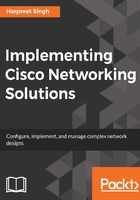
Edge computing
As IoT systems proliferate, and send more and more data, this data needs to be sent to the servers where it can be processed over the network infrastructure. This means that the data consumes bandwidth on the WAN links all the way up to the data center where the processing happens. More importantly, the data being sent from the edge to the DC takes a finite amount of time to be transported. Some data is time sensitive, and hence needs to be processed and reactive action taken with minimal latency.
As an example, consider that we are measuring the temperature of a hot furnace using a temperature sensor that is connected to the network using IoT protocols. This sensor would send the temperature of the furnace periodically to the central site. However, this means that a lot of data has to travel from the edge to the data center where the data can be processed. This has to traverse the WAN, and hence cause congestion on the network. If the application that monitors the temperature can be brought closer to the source of data, multiple problems can be addressed. First, the WAN bandwidth is conserved, as the data travels only until the server that is now not hosted in the DC, but is much closer to the source. Secondly, the latency is much less, and action can be taken quickly for time sensitive data. Thirdly, it helps the application to scale, by having a distributed model, where small modules of applications run closer to the source, enabling the overall application to handle much more data, and the central application can control the edge applications, and poll only processed data, which is much lower in volume.
This has led to the growth of edge computing, where small compute resources are placed closer to the edge, or source of data. Placing compute resources requires a controlled environment, and rack space, thereby adding to the operational problems, while the compute power required is not too large. Hence, newer ways of addressing these compute requirements have evolved, called edge computing. Some of the examples of these edge computing platforms are server blades on Cisco routers, or for even smaller compute requirements, the IOx application environment, where a Linux platform is provided natively on certain Cisco routers and switches without even using conventional Cisco computing hardware such as the UCS blades.